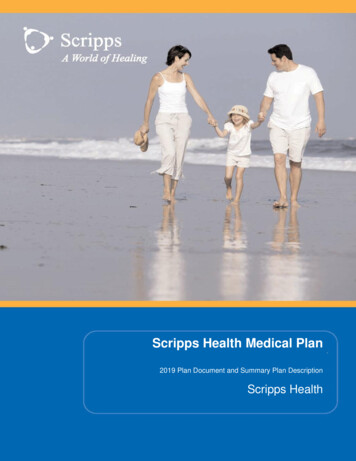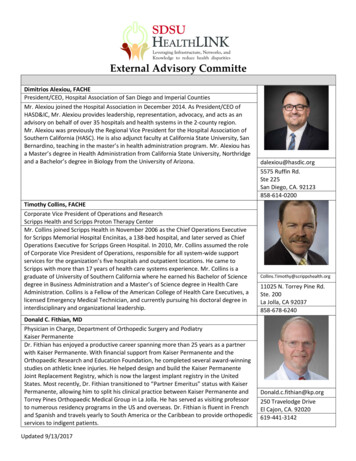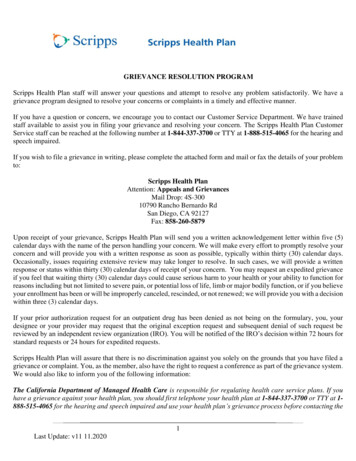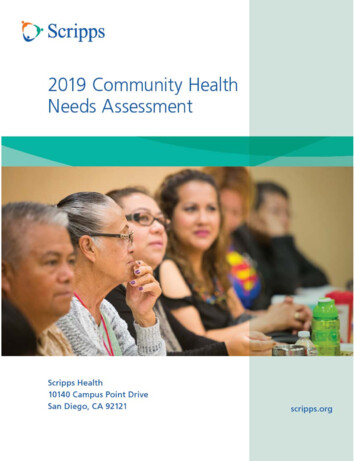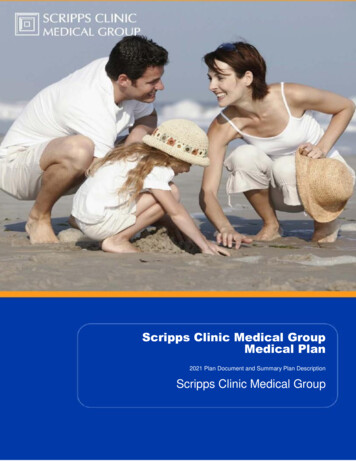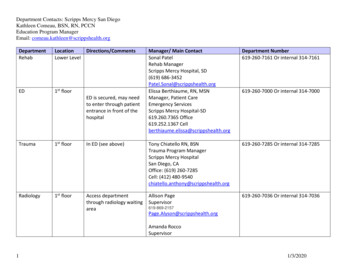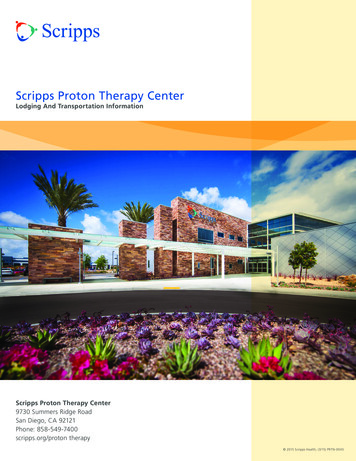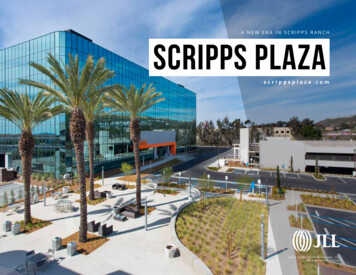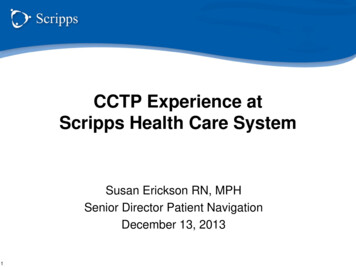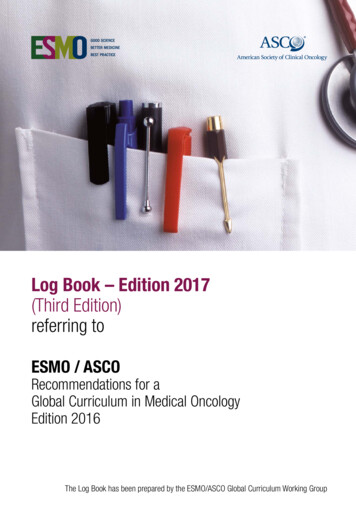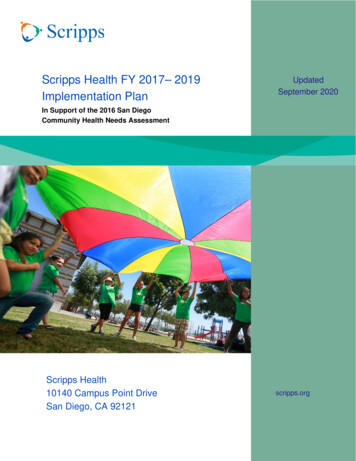
Transcription
Scripps Health FY 2017– 2019Implementation PlanUpdatedSeptember 2020In Support of the 2016 San DiegoCommunity Health Needs AssessmentScripps Health10140 Campus Point DriveSan Diego, CA 92121Scripps Healthscripps.org1F 2018 Implementation Plan
2019 Scripps Health Implementation PlanTable of ContentsAbout Scripps Health 4Background/Required Components of the CHNA & ImplementationPlan9Scripps Implementation Plan Strategy Team .10Scripps Implementation Plan Summary 11Health IssuesCardiovascular Disease 13Diabetes .42Behavioral Health .64Obesity 85Evaluation Plan .127Scripps Health2Implementation Plan FY19
Scripps Health 2019 Implementation PlanGeneral InformationContact Person:Anette BlattDirector, Community Benefits andAdvocacy, Office of the PresidentCommunity Benefit Services, zed governing body that adoptedthe Implementation Plan:Strategic Planning Committee of theScripps Board of TrusteesDate Implementation Plan was approved:September 2016Tax Year in which CHNA was madeavailable to the public:Tax Year 2016 (available on www.scripps.org)Scripps Mercy Hospital 40775th AvenueSan Diego CA, 92103090000074Name and state license number of HospitalOrganization Operating Hospital Facility:Address of Hospital Organization:*Scripps Mercy Hospital has a second campus in Chula Vista and they share thesame license.Scripps Memorial Hospital La Jolla9888 Genesee AvenueLa Jolla, CA 92037080000050Scripps Green Hospital10666 Torrey Pines RoadSan Diego, CA 92037080000139Scripps Memorial Hospital Encinitas354 Santa Fe DriveLa Jolla, CA 92037080000148Scripps Health3Implementation Plan FY19
Scripps Health 2019 Implementation PlanAbout Scripps HealthFounded in 1924 by philanthropist Ellen Browning Scripps, Scripps Health is a 3.3billion not-for-profit integrated health system based in San Diego, California. Scrippstreats more than 700,000 patients annually through the dedication of 3,000 affiliatedphysicians and more than 15,000 employees among its five acute-care hospitalcampuses, home health care services, and an ambulatory care network of physicianoffices and 30 outpatient centers and clinic (including 14 Scripps Health Expresslocations). Scripps also offers payer products and population health services throughScripps Accountable Care Organization, Scripps Health Plan and customized narrownetwork plans in collaboration with third-party payersToday, the health system extends from Chula Vista to Oceanside and is dedicated toimproving community health while advancing medicine. Recognized as a leader indisease and injury prevention, diagnosis and treatment, Scripps is also at the forefrontof clinical research, and wireless health care. With three highly respected graduatemedical education programs, Scripps is a longstanding member of the Association ofAmerican Medical Colleges. Scripps has been ranked five times as one of the nation’sbest health care systems by Truven Health Analytics division of IBM Watson Health. Itshospitals are consistently ranked by U.S. News & World Report among the nation’s bestand Scripps is regularly recognized by Fortune magazine, Working Mother magazineand AARP as one of the best places in the nation to work. More information can befound at www.scripps.org.SCRIPPS FACILITIES/DIVISIONSScripps Memorial Hospital EncinitasScripps Green HospitalScripps Memorial Hospital La JollaScripps ClinicScripps Mercy Hospital*San Diego & Chula Vista CampusesScripps HealthScripps Clinical Research ServicesScripps Coastal Medical CenterScripps Home Health CareScripps Whittier Diabetes Institute4Implementation Plan FY19
Organizational FoundationScripps provides a comprehensive range of inpatient and ambulatory services throughour system of hospitals and clinics. In addition, Scripps participates in dozens ofpartnerships with government and not-for-profit agencies across our region to improveour community’s health. And our partnerships do not stop at our local borders. Ourparticipation at the state, national and international levels includes work withgovernment and private disaster preparedness and relief agencies, the StateCommission on Emergency Medical Services, national health advocacy organizationsand even international partnerships for physician education, training and direct patientcare. In all that we do, we are committed to quality patient outcomes, serviceexcellence, operating efficiency, caring for those who need us today and planning forthose who may need us in the future.Approval from Governing BodyAs a tax-exempt health care system, Scripps takes pride in its service to thecommunity. The Scripps system is governed by a 14-member, volunteer Board ofTrustees. This single point of authority for organizational policy ensures a unifiedapproach to serving patients across the region. The Scripps Health Board ofTrustees Strategic Planning Committee approved both the triennial 2016 CHNAreport and corresponding Implementation Plan during its 2016 tax year. The 2017–2019 Implementation Plan is outlined in the remainder of this document and isupdated annually with metrics. The CHNA written report is posted separately on theScripps Health website, CHNA Report.About Scripps Health Community BenefitIn addition to the CHNA and Implementation Plan, Scripps Health continues to meetcommunity needs by providing charity care and uncompensated care, professionaleducational and an array of community benefit programs. Scripps offers communitybenefit services through our five acute-care hospital campuses, home-based healthservices, wellness centers and ambulatory clinics.Scripps Health documents and tracks its community benefit programs and activitieson an annual basis and reports these benefits through an annual report submitted tothe State of California under the requirements of SB697. Scripps Health communitybenefit programs are commitments Scripps makes to improve the health of bothpatients and the diverse San Diego communities. As a longstanding member ofthese communities, and as a not-for-profit community resource, Scripps’ goal andScripps Health5Implementation Plan FY19
responsibility is to assist all who come to us for care, and to reach out especially tothose who find themselves vulnerable and without support. Through our continuedactions and community partnerships, we strive to raise the quality of life in thecommunity.In FY 2019 Scripps documented more than 443 million in local community benefitprograms and services. For more information about the programs and servicesoffered by Scripps Health, visit www.scripps.org/communitybenefit or contact theScripps Health Office of Community Benefit Services at 858.678.7095.Scripps Health6Implementation Plan FY19
Scripps Health Community ServedHospitals and health care systems define the community served as those individualsresiding within their service areas. A hospital or health care system service areaincludes all residents in a defined geographic area surrounding the hospital.Scripps serves the entire San Diego county region with services concentrated inNorth Coastal, North Central, Central and Southern regions of San Diego.Community outreach efforts are focused in those areas with proximity to a Scrippsfacility. Scripps hosts, sponsor and participates in many community-building eventsthroughout the year.SCRIPPS HEALTHHOSPITAL/HEALTH CARE SYSTEM*Scripps Memorial Hospital La Jolla9888 Genesee Ave.LOCATIONLa Jolla92037Scripps Mercy Hospital4077 5th Ave.San Diego92103Scripps Green Hospital10666 N. Torrey Pines RoadLa Jolla92037Scripps Memorial Hospital Encinitas354 Santa Fe DriveEncinitas92024Scripps Mercy Hospital Chula Vista435 H St.Chula Vista91910*Locations represent the major hospital or health care/system locations and do not represent all types of hospital or health carelocations.The trended table below shows the primary service area as defined by those zip codesfrom which 70% of Scripps patients originate for inpatient discharge years 2013-2016(top 70% of inpatient discharges by zip code). Figure 1 is a map of Scripps Health andservice areas.Table 1 – Scripps Health Inpatient Discharges for Years 2013-2016 from which theTop 70% of Scripps Patients Originate2013201420152016San DiegoChula %6%5%3%36%8%6%5%3%36%7%6%6%3%National CityLa JollaSan MarcosVistaEl CajonGrand 3%2%70%Scripps Health7Implementation Plan FY19
Figure 1 – Scripps Health Service AreaScripps Health8Implementation Plan FY19
Background/Required Components of the Community HealthNeeds AssessmentIn 2010, Congress added several new requirements for hospital organizations tomaintain federal income tax exempt status under Section 501 (r) of the InternalRevenue Code (the “Code”) as part of the Affordable Care Act. One of the requirementsset forth in Section 501 (r) of the Code is for each hospital organization to conduct aCommunity Health needs Assessment (CHNA) at least one every three tax years. Therequirement to conduct a CHNA applies to Scripps Health, which is a health system thatoperates five hospital facilities.Background/Required Components of the ImplementationStrategyProvisions in the Affordable Care Act require a tax-exempt hospital to: Adopt an implementation strategy to meet community health needs identified inthe CHNA. Describe how it is addressing needs identified in the CHNA. Describe any needs in the CHNA that are not being addressed and the reasonsfor not addressing them.The written implementation strategy describes either: How the hospital plans to meet the significant health need. Describe actions the hospital facility intends to take to address each significanthealth need identified in the CHNA, and the anticipated impact of those actions,or identify the health need as one it does not intend to address and explain why. The anticipated impact of these actions.The programs and resources the hospital plan to commit to address the healthneed.Describe any planned collaboration between hospital facilities and other facilitiesor organizations in addressing the health need. Or The significant health needs the hospital does not intend to meet, explaining whythe hospital does not intend to meet the health need.Scripps Health9Implementation Plan FY19
Scripps Implementation Plan Strategy TeamThe Scripps Implementation Strategy Team included the following individuals:Scripps Executives Carl Etter, Corporate Senior VP, Regional Chief ExecutiveTom Gammiere, Corporate Senior VP, Regional Chief ExecutiveJune Komar, Corporate Executive Vice President, Chief of StaffClinical Care Line Leaders Jerry Gold, Administrator, Behavioral Health Clinical CareAthena Philis-Tsimikas, Corp VP, Scripps Whittier Institute Chris Walker, Senior Director, Scripps Whittier InstituteCommunity Benefit Representatives and Others Anette Blatt, Director, Community Benefits and AdvocacySandy Boller-Bilbrey, Director, Medical/Substance Abuse Services, Op Drug &Alcohol Treatment ProgramKendra Brandstein, Director, Community BenefitsKimberly Luu, Research Assistant, Scripps Whittier Institute, Administration Addie Fortmann, Manager, Diabetes Care Line Research, Scripps Whittier Institute,Administration George Hayes, Manager, Market OutreachKaren McCabe, Director, Community BenefitsKimberly Roberts, Director, Clinical Services, Community Health & Advocacy,Scripps La JollaLinda Couts, Stroke Program CoordinatorMonica Ruiz, Supervisor, Community Program & Research, Scripps Whittier InstituteKristine Osborne, Data Analyst, PLT TeamMarilen Collins, Director, Patient Care, Nursing Administration, Encinitas Mark Zangrando, Senior Director, Mission IntegrationScripps Health10Implementation Plan FY19
Scripps Health Implementation Plan SummaryScripps Health has a long history of responding to the health needs of the communitiesit serves, extending beyond traditional hospital care to provide community benefitprograms that address the health care needs of the region’s most vulnerablepopulations. Scripps strives to improve community health through collaboration.Working with other health systems, community groups, government agencies,businesses and grassroots movement, Scripps is better able to build upon existingassets to achieve broad community health goals.The 2016 CHNA identified behavioral health as the number one health need in SanDiego County. In addition, cardiovascular disease, diabetes (Type 2), and obesity wereidentified as having equal importance due to their interrelatedness. Health needs werefurther broken down into priority areas due to the overwhelming agreement among alldata sources and in recognition of the complexities within each health need. Within thecategory of behavioral health, Alzheimer’s disease, anxiety, drug and alcohol issues,and mood disorders are significant health needs with San Diego County. Among theother chronic health needs, hypertension was consistently found to be a significantpriority area related to cardiovascular disease, uncontrolled diabetes was an importantfactor leading to complications related to diabetes, and obesity was often found to cooccur with other conditions and contribute to worsening health status. The impact of thetop health needs differed among age groups, with Type 2 diabetes, obesity, and anxietyaffecting all age groups, drug and alcohol issues affecting teens and adults, andAlzheimer’s disease, cardiovascular disease, and hypertension affecting older adults.In addition to the health outcome needs that were identified in the CHNA ten socialdeterminants of health needs were also a key theme and referenced in all thecommunity engagement activities. These ten social determinants of health needs wereoutlined in order of priority. Food Insecurity and Access to Healthy Food, Access toCare or Services, Homelessness/Housing, Physical Activity, Education/Knowledge,Cultural Competency, Transportation, Insurance Issues, Stigma, and Poverty.Some of these social determinants of health needs are addressed within the four healthconditions identified in this report such as access to care, physical activity, andeducation/knowledge through various program interventions. The other socialdeterminants of health needs were not addressed in detail in the ScrippsImplementation Plan due to limited financial and staffing constraints and/or a lack ofexpertise or competency to effectively address the needs. In addition, some of theseissues are being addressed by other providers in the San Diego community who haveScripps Health11Implementation Plan FY19
more expertise. Scripps Health remains committed to the care and improvement ofhealth for all San Diegans and will look to the exploration of new opportunities and newpartnerships to address these needs and future needs identified.With the 2016 CHNA completed and health priority areas identified, Scripps Health hasdeveloped a corresponding Implementation Strategy, a multi-faceted, multi-stakeholderplan that addresses the community health needs identified in the CHNA. TheImplementation Plan translates the research and analysis presented in the Assessmentin actual, measurable strategies and objectives that can be carried out to improvecommunity health outcomes.Scripps Health anticipates the implementation strategies may evolve due to the fastpace at which the community and health care industry change. Therefore, a flexibleapproach is best suited for the development of its response to the Scripps HealthCommunity Health Needs Assessment (CHNA). On an annual basis Scripps Healthevaluates the implementation strategy and its resources and interventions; and makesadjustments as needed to achieve its stated goals and outcome measures as well as toadapt to the changes and resources available. Scripps describes any challengesencountered to achieve the outcomes described and makes modification as needed.In response to identified unmet health needs in the 2016 Community NeedsAssessment, during FY17–FY19 Scripps Health is focusing on the strategies andinitiatives, their measures of implementation and the metrics used to evaluate theireffectiveness described in the report.Scripps Health12Implementation Plan FY19
Cardiovascular DiseaseHeart disease is the leading cause of death for people of most racial/ethnic groups inthe United States, including African Americans, Hispanics and Caucasians. Between 70percent and 89 percent of sudden cardiac event occur in men. About two-thirds (64percent) of women who die suddenly of coronary heart disease have no previoussymptoms. Individuals with low incomes are much more likely to suffer from high bloodpressure, heart attack, and stroke.Heart disease prevalence reports the percentage of adults who have ever been told bya doctor that they have any kind of heart disease. In San Diego County (SDC), thereported prevalence is 5.8%. It is also a significant cause of death in San Diego with‘Diseases of the Heart’ ranked second, ‘Cerebrovascular Disease’ ranked fourth, and‘Essential (primary) Hypertension and Hypertensive Renal Disease’ ranked tenth. Theoverall death rate from coronary heart disease decreased by 3.5% from 2014-2016 butincreased among Black (8.7%) and American Indian/Alaska Native (29.4%) individuals. 1Figure 2 – Mortality Rates for Coronary Heart DiseaseMortality Rates forCoronary Heart Disease84.6983.8981.72201420152016According to data presented in the Scripps 2016 CHNA, high blood pressure, highcholesterol and smoking are all risk factors that could lead to cardiovascular diseaseand stroke. About half of all Americans (47 percent) have at least one of these three riskfactors. Additional risk factors include alcohol use, obesity, physical inactivity, poor diet,diabetes and genetic factors (CDC, 2015).County of San Diego Health and Human Services Agency Public Health Services, Regional & Community sa/programs/phs/community health statistics/regional-communitydata.html1Scripps Health13Implementation Plan FY19
Rates of ED discharge for Coronary Heart Disease increased by 35.3% from 20142016. The steepest increases were for those 45-64 years old (41.9%) and Asian/PacificIslanders (55.1%). Inpatient discharge rates decreased slightly (by 0.1%). 2Figure 3 – Hospital Discharge Rates for Coronary Heart Disease, 2014-2017ED Dishcarge Rates forCoronary Heart Disease28.733.4Inpatient Discharge Rates forCoronary Heart Scripps Health is addressing cardiovascular disease through the following programsand interventions:1. EricParedes Save A Life FoundationScripps Health is addressing cardiovascular disease in our partnership with the EricParedes Save A Live Foundation. Eric was a healthy Steel Canyon High Schoolsophomore athlete who died suddenly and unexpectedly from Sudden Cardiac Arrest(SCA) in 2009. His parents established the EP Save A Life Foundation which providesfree screenings to youth in order to identify cardiac anomalies that may lead to SCA,with the ultimate goal of standardizing cardiac screenings among the youth. Thisprogram helps to prevent sudden cardiac arrest and death in middle and high schoolaged children, including underserved areas in San Diego County, through awareness,education and action. It’s most common in student athletes. Each year 7,000 teens inthe United States lose their lives due to sudden cardiac arrest. SCA is not a heartattack, it is caused by an abnormality in the heart’s electrical system that can be easilydetected with a simple EKG. If abnormalities are detected, a second test called an echocardiogram; an ultrasound for the heart is administered.2California Office of Statewide Health Planning and Development, OSHPD Patient Discharge Data. 2014-2016. SpeedTrack Scripps Health14Implementation Plan FY19
Sudden cardiac arrest is the leading cause of death on school campuses and thenumber one killer of student athletes. While studies show that 1 in 300 youth has anundetected heart condition, heart screenings are not part of regular well-child exams orpre-participations sports physicals, even though the first symptom of sudden cardiacarrest could be death. Free youth heart screenings provided by the Eric Paredes SaveA Life Foundation are non-invasive and include a cardiac risk assessment, and EKG, aconsultation with a cardiologist and if indicated, an echocardiogram. Since 2010, thefoundation has screened 29,610 youth, finding 476 with cardiac abnormalities requiringfollow-up serious enough to put the youth at risk for sudden cardiac arrest. In 2018, 81percent of youth screened participated in school or community sports programs. Morethan half of youth screened represent diverse ethnicities, while 39% were fromextremely low to moderate income households. Nearly 250 youth indicated they did nothave a regular pediatrician, while four percent were uninsured. Of parents surveyed, 61percent indicated they were not aware of the need to actively prevent SCA in youth,while unaware of warning signs and risk factors. When findings are positive, Scrippstakes the following steps: Checks for an abnormal heartbeat that could signal an underlying heart conditionusing an echocardiogram. Notifies parents of the results for follow-up with their family physician.StrategiesScripps partners with local San Diego schools to administer and readelectrocardiograms and if warranted an echocardiogram screening by Scrippsphysicians (cardiologist) before high school students participate in organized sport andactivities. As a sponsor of the Eric Paredes Save A Life Foundation, Scripps has heldmore than 10,000 free cardiac screenings for local teens, including the homeless andthe underinsured. Scripps provides financial contribution annually to help pay for thescreenings.Scripps Health15Implementation Plan FY19
Evaluation Methods and Measurable TargetsTable 2 – Results: Eric Paredes Save A Life FoundationObjective(s): To prevent sudden cardiac arrest and death in middle and high school agedchildren, including underserved areas in San Diego county through awareness, education andaction.Performance Measures201720182019In the total number of adolescent3,5334,9153,409*Screenings, 6.8% of the 3,409* wereuninsured adolescents.Total number of adolescents with353226positive finding of heart abnormalities.Total number of high-risk132314adolescents identified.2. Adults Screening in Conjunction with the EP Save A Life“Screen Your Teen” EventsStrategiesScripps Health empowers community members with cardiovascular screenings,education and support. Scripps promotes accountability and behavior change througheducation on chronic disease self-management by providing Lipid panel/glucosescreenings, body analysis screenings and heart care information for adults inconjunction with the EP Save A Life “Screen Your Teen” events.Evaluation Methods and Measurable TargetsTable 3 – Results: Adult Screenings: Eric Paredes Save A Life FoundationObjective(s): Empower community members with cardiovascular screenings, education andsupport. Promote accountability and behavior change through education on chronic disease selfmanagement.Performance Measures201720182019*Track number of cardio check tests for20360adults screened080Track number of adults found at riskTrack number of referrals080No screenings were conducted in FY19, focusing available time and resources onscreening youth athletes.Scripps Health16Implementation Plan FY19
3. Sweetwater Union High School District Pre-Participation SportsScreening AssessmentsScripps Health prevents sudden cardiac arrest and death primarily in the South Bay, forhigh school aged students by increasing education and awareness related tocardiovascular screenings and healthy lifestyles.StrategiesScripps partners with local Sweetwater High School District yearly to implement cardiacscreenings and sports physicals before students participate in organized sports. ScrippsCommunity Benefits, Chula Vista Scripps Family Medicine Residents assist with thescreenings. Metrics are collected via surveys bi-annually and insurance information iscollected via surveys at injury clinics. Thirteen injury clinics were held in 2019. Thesports physicals are conducted once a year before students participate in organizedsports. Refer to table 4 for performance measures.Evaluation Methods and Measurable TargetsTable 4 - Sweetwater Union High School District Pre-Participation SportsScreening AssessmentObjective(s): To prevent Sudden Cardiac Arrest (SAC) and death in South Bay/Chula Vista highschool students by increasing education and awareness related to cardiovascular screenings andhealthy lifestyles.Performance Measures201720182019Total number of youths screened8141,025219Number of youths with heart abnormalities120Percentage of individuals that are underserved51.9%51.9%59.9%(based on enrollment in school lunch program)Number of injury clinics held during footballseason. Dates: 8/23/19, 8/24/19, 8/27/19,22138/29/19, 9/3/19, 9/5/19, 9/6/19, 9/7/19, 9/10/19,9/12/9, 9,20/19, 9/21/19, 9/28/19.4. Su Corazon, Su Vida / Your Heart, Your Life – Scripps MercyHospital, Chula VistaScripps Health supports individuals to manage their heart health through a communityintervention program which decreases the readmission rates for heart failure patients,reduces medical costs for patients and improves their quality of life in underservedpopulation in the South Bay San Diego, and underserved community along theUS/Mexico border region.Scripps Health17Implementation Plan FY19
StrategiesScripps implements a five-week educational based community intervention program tosupport improved quality of life for patients diagnosed with heart disease. Patients in theintervention group are followed up weekly via phone for five consecutive weeks. Thesecalls are focused on motivational support and encouragement. An educational packet isgiven to support the initial educational seminar that includes information from the YourHeart, Your Life curriculum. Refer to table 5 for performance measuresEvaluation Methods and Measurable Targets Participants receive an initial heart health educational session that includesreview of daily-self assessment, salt avoidance, and exercise and medicationadherence. Outcomes explored include decreased hospitalizations and improved biometricmeasures including weight and blood pressure pre and post.Readmissions related to heart failure are tracked in each participant. (Thenumber of times a patient is admitted to the hospital for a condition related toheart disease is tracked over the course of the intervention).Each participant is given a “Health Habits” pre-test and post-test to measurebehavior change. Table 5 - Su Corazon, Su Vida – Your Heart, Your LifeObjective(s): Empower Latina women to manage their heart health through a community interventionprogram which decreases the readmission rates for heart failure patients and improves their quality of lifein the underserved population in South Bay, San Diego, and underserved communities along theU.S./Mexico border region.Performance Measures201720182019Number of initial Heart Health663334Education participantsBaseline Health Habit Pre/Post erall Unhealthy BehaviorOverall Healthy BehaviorAverage Pre/Post Weight (after a 12-month period)PrePostAverage Pre/Post Blood PressurePrePostNumber of Heart FailureReadmissionsScripps Health21890Implementation Plan FY19
5. Stroke Risk ProgramStroke was the fourth leading cause of death in San Diego County in 2016. Death ratesfor stroke increased by 17.6% from 2014–2016. The increase was steepest forHispanics (28.5%). 3Figure 4 – Mortality Rates for Stroke, 2014-2016Mortality Rates for Stroke41.4235.2335.6201420152016Rates of ED discharge for stroke increased by 11.0% from 2014–2016. The steepestincreases were for those 27–44 (20%) and for people who identify their race as “Other”(28.9%). Rates of Inpatient discharge for stroke decreased by 4.1%. 4Figure 5 – Hospital Discharge Rates for StokeED Dishcarge Rates forStrokeInpatient Discharge Rates .520152016Seventy to seventy-five percent of strokes and heart attacks can be reduced byeliminating risk factors. Scripps and its partners will work to make San Diego a heartCounty of San Diego Health and Human Services Agency Public Health Services, Regional & Community sa/programs/phs/community health statistics/regional-communitydata.html34California Office of Statewide Health Planning and Development, OSHPD Patient Discharge Data. 2014-2016. SpeedTrack Scripps Health19Implementation Plan FY19
attack and stroke free zone by educating and engaging individuals and communities inunderstanding and taking action to address the risk factors that cause heart attack andstrokes.StrategiesScripps Health educates and engages the San Diego community for stroke by attendingat least one community event and screening for stroke via a stroke risk factor score cardand educating individuals on the FAST test. The FAST test was developed in the UK in1998 by a group of stroke physicians, ambulance personnel, and emergency roomphysician and was designed to be an integral part of training package for ambulancestaff. The FAST test is an easy way to recognize and remember the most commonsigns of stroke. Using the FAST test involves asking three simple questions. Theacronym stands for Facial drooping, Arm weakness, Speech difficulties and Time. Facial drooping: A section of the face, usually only on one side, that is droopingand hard to move. Th
A hospital or health care system service area . North Central, Central and Southern regions of San Diego. Community outreach efforts are focused in those areas with proximity to a Scripps facility. Scripps hosts, sponsor and participates in many community-building events . The 2016 CHNA identified behavioral health as the number one health .
